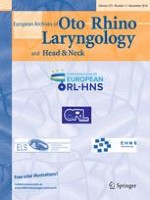Erschienen in:

18.09.2018 | Short Communication
The (templar) knight cap: a new and simple way to prevent hair interference during ear surgery
Erschienen in:
European Archives of Oto-Rhino-Laryngology
|
Ausgabe 11/2018
Einloggen, um Zugang zu erhalten
Abstract
Introduction
Hair interference is a critical problem in ear surgery. The hair around the surgical area can get stuck unwantedly, making the surgeon habitually struggling with this hair rather than the surgery itself. Hair shaving can cause psychological discomfort, especially for women and data about shaving efficacy are conflicting. With the aim of solving this problem, we developed a new way to clear hair from the operating field named "The (Templar) Knight cap".
Technical description
This is a medical elastic stocking open at the ear to be treated and at the face that recalls the typical cap worn by Templar knight. This cap allows good hair retention and marks the surgical site. It is easy to wear does not require additional time for clinical staff.
Conclusions
The described cap could be a valid instrument during ear surgery with a low cost pricing, making it applicable in very poor settings, such as developing countries.